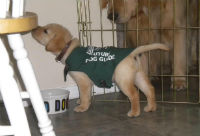Gloria Peckham recalls how a British Columbia man, who received a seizure response dog she trained, is now living independently because of the canine.
The man has a severe seizure disorder, and health authorities suggested he move into a group home because he experiences so many seizures. However, because the man now has a seizure response dog trained to press a Lifeline button as soon as he has a seizure, he is living on his own.
“Without that dog, he would not be able to live independently,” Peckham says.
This is just one of many successes seen by Peckham, the head trainer at Canada Dog Guides. These special animals are giving many people affected by seizure disorders a new lease on life, she says.
It’s a thorough training process the animals must go through on the road to becoming seizure response dogs, Peckham explains.
A trainer will have approximately eight dogs to start training. Trainers look for dogs that are attentive to the handlers; dogs with a pleasant disposition but also confident enough that they won’t be scared by loud noises, she says.
Here’s how the training process works:
First, the dogs are taught to bark for help with a word command; the command will eventually become a shaking body, replicating a seizure. Dogs are then taught to activate alert systems, in other words, hit a button, and finally the dogs are taught to seek help in a home environment.
“Once we have the dog about halfway through the training and we see what type of dog we have, we’ll then go to our waiting list and take the first people off the top of the list to see what their needs are, their lifestyle, and we start matching the dog to the person.”
Once a match is found, the dog will be trained to respond to the specific type of seizure the person is experiencing. For example, some people have a distinct noise they will make prior to a seizure, while other people will shake. The dogs are trained to respond to specific cues that their owner is having a seizure.
To qualify for a seizure response dog, people need to experience several seizures a month for the dogs to be effective. They also need to practise having seizures to keep the dogs’ senses fine tuned.
Dog Guides Canada specializes in training several breeds: Labrador retrievers, golden retrievers, standard poodles and miniature poodles. Dogs typically take four to six months to train. Candidates for seizure response dogs attend a three-week class at the Dog Guides Canada training facility in Oakville.
Click here for more information on Dog Guides Canada.
Writer: Deron Hamel
If you have feedback on this story, or have a story of your own that you would like to share, please contact the newsroom at 800-294-0051, ext. 23, or e-mail deron(at)axiomnews.ca. You can also leave a comment below.






